 |
|||||||||||||||||
 |
You can now take flights on the Zeppelin NT Airship “Eureka” over San Francisco, Silicon Valley, Santa Cruz , Monterey, and Los Angeles. For more information go to: Airship Ventures. |
||||||||
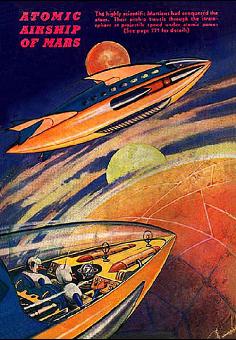 |
|||||||||
The size of "Eureka" is evident in the photo below with the mooring mast truck and ground crew. After taking flight, the majestic Airship Ventures Zeppelin NT is a site to awe even the most jaded observer. (additional photos following the article.) |
|||||||||
 |
|||||||||
Fanciful rendering of a Martian Airship. |
|||||||||
Airship to the Future Flying aboard Airship Ventures' Zeppelin NT "Eureka" by Michelle Evans
Time is a precious commodity. No one ever has enough of it. We rush everywhere, darting around in traffic to make up for lost minutes in congestion, or fast forwarding through the slow moments of a favorite TV program. Sometimes we are so flustered by having too many things to do at once that we just stop everything—the world coming to a complete halt, even if just for a second—just so you can take a breath before you start your frenzied life again. We have cell phones, blackberries, wi-fi, everything to keep us in touch and on the go.
How many of us travel often on business, while rarely for pleasure? Considering the time spent going through security, grabbing a tiny seat with no leg room, and all the other inconveniences, we may not even want to try unless we have no choice. Flying, which used to be so wonderful, soaring across our planet at high speed and high altitude, has now become a drudge to be avoided. There was a time when flying was something more akin to a slow ocean cruise. This was during the golden age of the Zeppelin, gone now from our skies for more than seven decades.
All this has finally changed with the resurgence of the new technology (or NT) Zeppelins. Built by the same German company that created the original rigid airship designed by Count Ferdinand von Zeppelin, which first flew over Lake Constance at Friedrichshafen on July 2, 1900. The first three of these Zeppelin NTs have now been in the air for several years over Germany and Japan, while the fourth was brought to America in October 2008 by the founders of Airship Ventures, Brian and Alexandra Hall. This is now the first and only rigid airship in the U.S. that flies ticketed passengers. These may not be the same luxury flights across the ocean of bygone days, but flying in a Zep, even for an hour or two, can have a profound effect on your outlook on life.
“At Airship Ventures,” Alexandra (or simply, Alex) Hall, the company CEO, and spouse of Brian, told me prior to a recent flight, “we joke that we’re in the ‘Joy Business’ because every single person that flies on the airship is having this joyful experience. You can’t be grumpy and watch this beautiful aircraft fly over you. You have to look up and wave. Every single day we’re doing things that make people incredibly happy. It’s just such a wonderful thing to do.”
The idea of flying Zeppelins again has been floating around for many years. There are plans on the drawing boards for huge behemoths that can shuttle cargo or passengers across the Earth, or even to fly on the winds of other planets for exploration and scientific discovery. This latter idea is one which particularly appeals to Alex. Prior to the creation of Airship Ventures, she served as the Executive Director of the Chabot Science Center in Oakland. In her heart, she has always had the calling to space.
In order to move ahead with the concept of what a rigid airship might be able to accomplish in the area of research, Alex explained, “We have a Space Act agreement with NASA, and under that agreement [we are] to determine the characteristics of this unique aviation platform. It’s very low vibration compared to a helicopter or a small plane. We fly very low; we fly very slow, and that means the resolution of the data we can get is very good indeed. We’re stationed at NASA Ames [and] there’s two good reasons for that. Number one, they have airship hangars there; but, number two, Ames is a center of aviation excellence and allows us to be working with researchers at NASA that are looking at using airborne platforms for doing a number of different types of scientific research. We probably have about 50 different experimental inquiries right now that are on our books; people wanting to explore using the airship for all these different types of research. I’m very excited about the potential for [our] platform, and I think that will become a significant part of what we do. Hopefully, we’ll be able to do some of that while we’re also carrying passengers, so perhaps [they] can learn a little about the science that we’re doing, why it’s important; gives us an extra teachable moment.
“The first flights on that agreement will be in October,” Alex continued. “You guys are getting a marvelous scoop. It’s pretty well known that we’re working with NASA on this, it’s just that NASA’s had plenty of things to be talking about in July and August [with the Apollo 11 anniversary events and the Augustine Commission], and signing a Space Act agreement with us is a small thing. We will probably choose to talk about this a lot at the time we do the first flight, which, at the moment, is in October.”
Getting detailed views of our planet, and the changes that are affecting our climate, food, and water, are of tremendous importance. Remote sensing satellites with high resolution are launched at a cost of tens to hundreds of millions, or even billions, of dollars. They speak of having resolution in the meter range (about three feet) from high Earth orbit. But think of the ability to see these objects at centimeter or millimeter scale by flying just a thousand feet or so above the planet, and at a substantially lower magnitude of expense. The potential return for our Earth is astronomical.
But what of the idea of going farther, going to other planets, possibly Mars or Venus, or even the Saturnian moon Titan?
“What we bring to the table,” Alex told me, “in a lot of these discussions with NASA, and others that are investigating airships for planetary exploration, is that we have the experience of ground handling and flying these things. You can have engineers at Lockheed or Boeing that are busy designing these 800-foot, high-altitude monsters. But those engineers do not have the experience of handling a lighter-than-air vehicle of that size, and with all the different things you have to think about realistically for operating an airship. So what we bring to the discussion is, how does this work. Our pilots can interface with the engineers, particularly if they’re starting to look at simulations of how a vehicle will fly. Our pilots can provide feedback on what the flying, the experience, will be like. So these are practical things that we can bring into that discussion.”
Alex yearns for the exploration that drives our souls. “Now, when we’re thinking further ahead,” she said, “like planetary exploration, then we dream just as much as all the other engineers. One of the places I’ve always wanted to take an airship is actually Venus, to do upper-altitude, high-altitude [science]. In the upper atmosphere there, you can learn an awful lot about the surface by putting an airship [there] and basically letting it be blown around in those very, very rapid wind systems at the top of the planet. What’s great about this is because Venus’s atmosphere is so dense, there’s a lot of different gases you could use. Basically, a bubble of air would be good enough to keep you aloft and buoyant in the atmosphere of Venus. Maybe even Titan, [which has] a very, very dense atmosphere, cold. Again, a lot we could learn. What’s great about airship technology is that you can fly your gondola, the business end of it, to wherever you want to go, then, when you get there, to inflate it with whatever your lifting gas is. You can get the benefits of having a very large exploration vehicle, but you don’t have to send all of that stuff. You’re just sending the envelope there.”
As for how the first Zeppelin to return to America came to be, Alex told me of the fateful flight her husband, Brian, took in a Zeppelin NT in Germany. “He said, ‘I flew on this airship and it’s the most amazing experience. I think we should do this in California.’ So, as I hadn’t got anything else to do [laughs], I thought it might be fun to take a look. I remember him coming back from the flight and being totally excited about this experience and how incredible it had been to see civilization from this bird’s-eye perspective. He was struggling to describe it, and I find that when somebody is struggling to come up with the right words, it’s typically because there really isn’t a good way to describe it, and therefore, you just have to experience it.”
That was the way to describe the recent flight I took with Cherie Rabideau, and several others on the “Eureka.” In the hands of two expert pilots, Jim Dexter and Fritz Günther, flight attendant Elaine Jumes, and founder Brian Hall, we quickly lifted off vertically, unlike the Goodyear blimp that takes off at a steep upward angle. With the rigid framework, the powerful engines are mounted well away from the gondola, so there is little sound except the wind as we climb and accelerate to approximately 35 mph. Maybe not fast by rocket ship standards, but a perfect way to experience your planet from low altitude.
As we tooled around the coastline near Long Beach and Palos Verdes, we saw whales crashing and diving beneath us, and even a pod of at least 50 dolphins jumping and playing as they chased our giant shadow across the calm coastal Pacific. We passed over the Queen Mary and Spruce Goose dome, followed right after by the two ships of Sea Launch berthed nearby. The buildings we passed over and vehicles driving the streets, were small toy models from our avain vantage. It was actually one of the hottest, and most humid days of the year when we took our flight, miserable by most anyone’s standards, yet we all felt it was a grand day out. As Brain said during our flight, “It never gets old. Every single flight is different.”
Why the Airship “Eureka?” I asked Alex. “Brian and I picked the name Eureka very early on,” she responded. “It came from the title slide of a powerpoint presentation that one of the Zeppelin engineers put together when we were looking at the logistics of getting the airship from Germany to California. He called it ‘Project Eureka.’ When we saw that, we thought it was great! First, it was the California state motto. Second, it linked us to Archimedes and the principles of buoyancy, which is how we fly. And third, it means ‘I've found it’ which is what we feel about the experience aboard [our] airship!”
Currently, Airship Ventures operates a single Zeppelin in America, but hopes to expand that operation to at least three. Maybe in some (hopefully not too distant) future, they may become the operators of vehicles roaming the skies of our neighbors in space.
“Both of us are really interested in going into space,” said Alex of herself and Brian. “We’ve always wanted to do that. I think if we weren’t doing Zeppelins, we’d be more involved with the new space stuff that [is] going on. I do think I’m going to get to space one day. I’m not quite sure how that’s going to be. I don’t know that it will be making a great fortune in running a Zeppelin company. I suspect not. But I do think that I’ll find a way. When we started to tell people we wanted to bring Zeppelins back to America after 70 years, [they] would say, ‘You’re crazy; you’re really crazy! What are you trying to do?’ So I think that, if you want to do something badly enough, you figure out a way.” XXXX |
||||||||||||||||
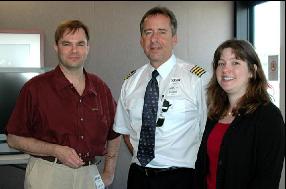 |
||||||||||||||||
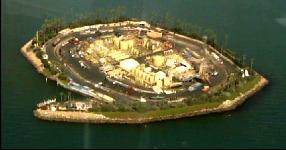 |
||||||||||||||||
(L-R) Brian Hall, founder of Airship Ventures, our pilot Jim Dexter, and CEO Alexandra Hall. |
||||||||||||||||
Island Chaffee from a thousand feet. |
||||||||||||||||
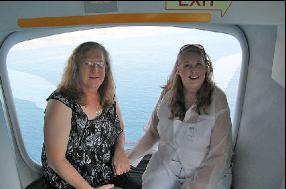 |
||||||||||||||||
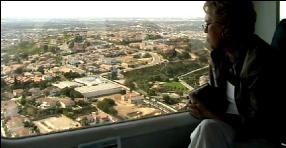 |
||||||||||||||||
Every seat has a spectacular view. |
||||||||||||||||
The author and her wife at the rear love seat and panorama window in the airship's gondola. (photo courtesy of Brian Hall) |
||||||||||||||||
 |
||||||||||||||||
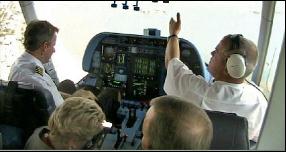 |
||||||||||||||||
(above and below) Chasing your shadow is a popular pastime aboard "Eureka. |
||||||||||||||||
Jim Dexter and Fritz Gunther at the controls of the Airship "Eureka." |
||||||||||||||||
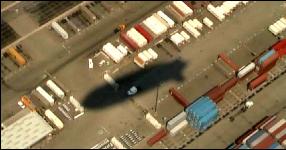 |
||||||||||||||||
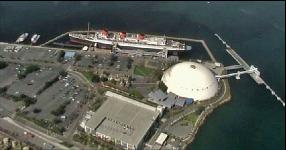 |
||||||||||||||||
A popular Southern California site: The Queen Mary and Spruce Goose Dome. |
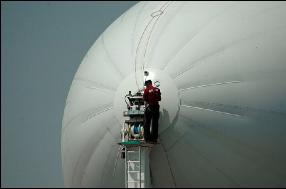 |
|||||||||||||||
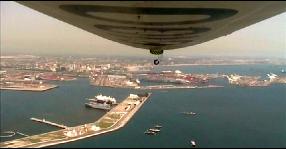 |
||||||||||||||||
The Long Beach area from the vantage of the gondola's rear panorama window. |
||||||||||||||||
A ground technician at the mooring mast as "Eureka" is refueled. |
||||||||||||||||
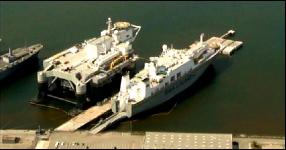 |
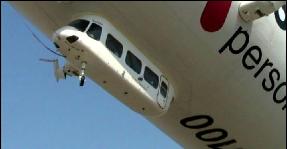 |
|||||||||||||||
The two ships of Sea Launch. (L) Launch Platform "Odyssey" and (R) the command and assembly ship "Sea Launch Commander." |
||||||||||||||||
Liftoff for another wonderful flying experience. |
||||||||||||||||
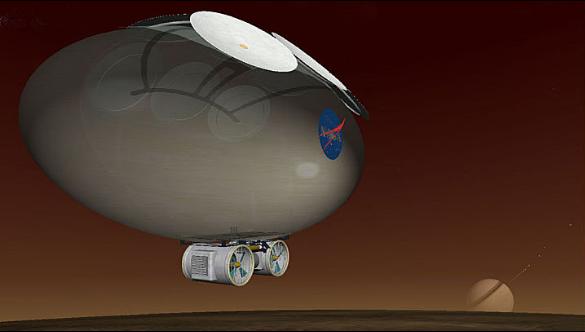 |
||||||||||||||||
An airship concept that could be used to explore Saturn's moon Titan for possible organic molecules. (image courtesy University of Arizona, Lunar and Planetary Lab) |
||||||||||||||||
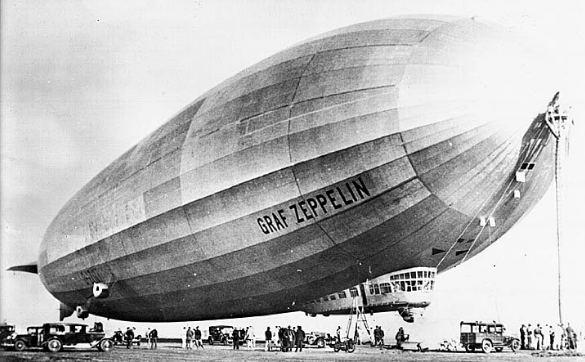 |
||||||||||||||||
The D-LZ 127, Graf Zeppelin. |
||||||||||||||||
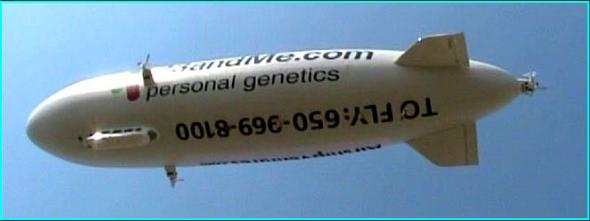 |
||||||||||||||||